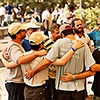 To subjugate myself does not mean to submit like a donkey so that everyone can ride me. I subjugate in relation to the Creator and enjoy this state, which comes precisely after the strongest eruption of egoism.1
To subjugate myself does not mean to submit like a donkey so that everyone can ride me. I subjugate in relation to the Creator and enjoy this state, which comes precisely after the strongest eruption of egoism.1
We come to connection from a desperate state, from feeling lost and powerless, when we are crying and demanding help from the Creator. Otherwise, we would be unable to feel connection in the right place—in the heart, in the desire.
Connection is a feeling in my heart, of life that happens in the heart of a friend. My heart only feels, but it lives the life of a friend. For this, I must convince myself that the Creator is in the heart of a friend and if I want to reach the Creator, I must come closer to a friend.
Connection is a feeling of mutual dependency, when I feel that I fully depend on others: on their success, achievements, health, on everything. That is why we are attached to our family, because we understand that we depend on it. If family members are healthy, it is good for me; if they are successful, this also benefits me. This is how our desire to receive works in its most primitive form: pleasure/suffering, detachment/connection, pain/absence of pain.2
The full measure (Seah), after which a qualitative change happens in us, is made up from the quantity and quality of changes that includes the number of actions, the number of years, and the total of invested efforts. Those are quantitative indicators, but from quantity comes a new quality.
All our efforts are aimed only at softening our hearts. The full measure means that the shell of our heart is broken. The heart is covered in a shell, and it must be broken “to get to the answer.” Even one crack is enough in order to begin feeling some contact with spirituality and our shattering. Prior to this a person does not even feel the shattering, his heart is just deaf.
It is impossible to break the shell with one blow. This is similar to the way a chick hatches from an egg: it knocks and knocks at the shell until it cracks and allows it to get out. However, in our case it is even more difficult because the shell not only does not break with one blow, it is also impossible to break it alone, but only together with the friends! This will take a lot of strikes that are made together.
Then whose shell am I breaking: mine or a friend’s? The shell is neither mine nor his, but it is between us. As it is written, “They helped every one his friend.” The friend knocks from his side and I knock from mine, and only together will we be able to break this shell between us.3
From the 1st part of the Daily Kabbalah Lesson, Baal HaSulam, Introduction to The Study of the Ten Sefirot, item 74
From the 1st part of the Daily Kabbalah Lesson, Baal HaSulam, Introduction to The Study of the Ten Sefirot, item 74

















